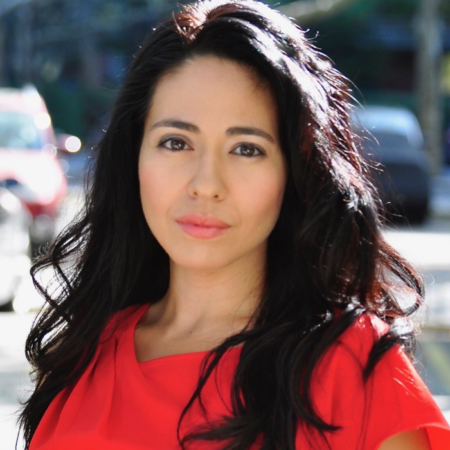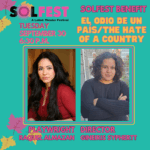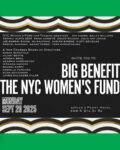Medium interview via Life Jacket Theatre Company, Meet Teaching Artist Raquel Almazan
- An in-depth interview about embracing radical inclusivity, telling urgent undertold stories, and rethinking the future of theatre. Article link: HERE
- 2nd interview via Fordham University 90.7 wfuv.org Radio Podcast: The Life Jacket Theatre Company’s Storytelling Project: HERE
What do you think the biggest challenge is in working towards a more diverse artistic community?
One of the largest challenges will be to move past performative statements of solidarity and truly do the work to diversify once we are in physical spaces together again.
There are large sacrifices one makes to pursue theatre not just as a profession but as a life’s journey; to have institutions aware of the fragility of the lives of artists is key in our field. My hope is that an anti-oppression, anti-racist framework is instilled in every theatre, we are going to need a framework of maintaining our community in order to continue as a field. I hope that urgency in narratives, what is most at stake, stories of people of color, and immigrant representation are prioritized on stages. That the visibility of vulnerable communities most affected by COVID-19 will also be reflected in the allocation of resources in our field, that we radically distribute resources for BIPOC, LGBTQIA, immigrant and disabled artists. That our theatre field cultivates a responsive lens in curating, in its mission, including the evaluation of high paying salaried positions vs freelance positions in our field.
When was the first moment you can remember feeling inspired to create art?
In my youth, visual art was my first interest and awareness in art making. I loved free form painting and drawing. During a time in my childhood I lived in a domestic violence shelter and became connected to other women’s narratives through circle sharing, storytelling. That’s when I became interested in visualizing the stories, words in combination with color and paint. I became interested in how stories could be told on a moving canvas, which for me later became the theatrical space and filmmaking. The isolation in how we experienced our own traumas was lifted through this active imagination of words that could move. The experience in finding solidarity in one another’s stories inspired me to continue to discover and connect with thousands of people on my journey.
What is the number one thing you hope a student leaves one of your workshops with?
Empowerment and connection to identity. To be rooted with confidence in one’s own identity cultivates a strength in how we navigate the world, critical thinking and challenging our own assumptions in what we thought could be achieved.
And let’s not forget joy!
What are a few perks or hindrances you’ve experienced with art going virtual?
The virtual space for me has actually created opportunities to connect with artists, students and audiences in new ways. Collaborations online have enabled international exchange, released the concerns of renting space and provided a platform for marginalized voices and makers. I think this time has naturally been reflective and we are all examining the harmful ways in which we have been practicing. We’ve gotten some distance from what I term “the old ways,” there’s time to dismantle the way we engage. The online world magnifies the way we engage and practice, we can identify, see in a fresh way and have agency in how and what we engage with.
The hindrances are that we assume that everyone has access to technology and providing everyone with the tools and resources has been a challenge. This raised a need for more awareness, this is part of equity as well, access to online tools. There has been a blurred line between the space we “work” in and “live” in. We’re entering into one another’s private spaces and that’s become a “new” shared space.
Loving the Zoom background feature too, it can take you anywhere!
What was your first experience as an educator and how have you grown or changed since that time?
As a teaching artist to incarcerated women at a maximum security facility through ArtSpring Organization, the process entailed building original pedagogy with the women that culminated in a public performance. The youngest of the participants, who had a life sentence performed for this audience inside the facility and with the aid of supporters and a legal team that had been working on her release for several years, some members of that audience aided her in being released a year and a half after the presentation. While this is a unique case, it proved to be an example that the process of creating art and the active role of witness and engagement can begin to change the system. And that power lies in the participants who lead and shape this new reality.
Years after this experience, I still believe that it is only through art, which I view as a spiritual, political and communal practice, that we truly expand individually and as a collective. The growth now is understanding and acknowledging that every education process is unique. I believe the the facilitator must engage in a constant inquiry of ethics when working with communities. Deep listening, unlimited empathy and the ability to hold space is only achieved when the facilitator has critically analyzed their own placement of privilege in the world, in a community and in every room.
You were recently featured in the New York Times article, “20 Theater Figures on How to ‘Revolutionize’ Their World.” Can you elaborate on your ‘couch statement’?
I feel very strongly about not seeing anymore couches on stage. Part of dismantling the “the old ways,” is for me is to name the history of the dominant culture, the productions of white middle class narratives taking place in living rooms. The well made play, the default living room narrative, the outdated obsession with realism is at the heart of what limits representation in the United States.
This couch immediately restricts our choices as theatre makers, what could have empowered the maker in the space with 1,000 choices has now reduced the tools of the maker to blocking arrows around a couch.
The full breath of global storytelling does not sit on a couch; it moves, dances, thrashes, breaks apart walls, challenges the imagination, honors all existing worlds and allows us create new worlds.




